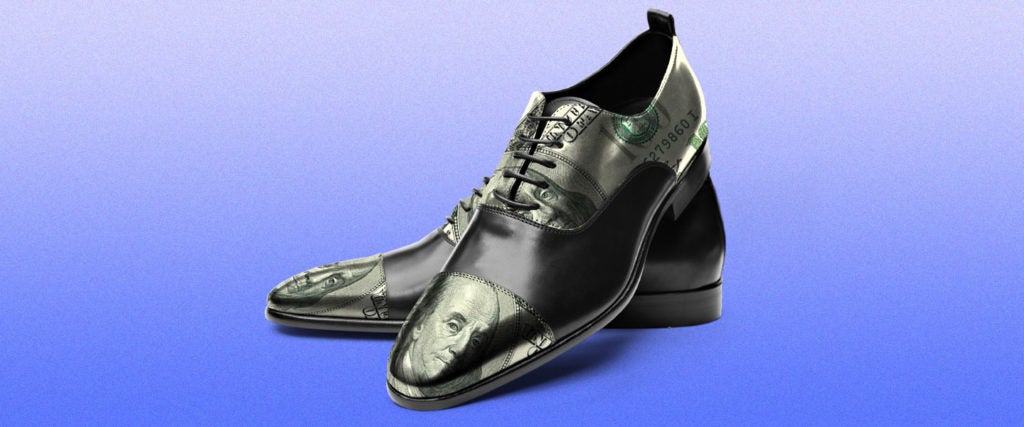Whether we’re talking about wingtips or fancy-ass “work boots” (lol), dressy men’s footwear can really do a number on your credit card. So why are dress shoes so expensive? Yeah, there are a million shoe brands out there nowadays, and some of them pump out cheapo dressy footwear. But why does, let’s say, non-sneaker footwear have to cost so much? And by the way, those cheap dress shoes: Why are they cheap, anyway?
Alongside Leslie Gallin, former president of Informa Markets, who’s a longtime industry veteran of footwear trade shows, we’re slipping on some answers.
Okay, why are dress shoes so expensive?
It’s because shoes don’t exactly fly down a conveyer belt like candy in I Love Lucy — there’s a lot of human touch involved, according to Gallin. Matching the right foot to the left isn’t easy to do, for one thing, and certain construction methods are more time-consuming (more on that in a bit).
It’s also gotta be the leather, right?
Ah, yes. Think how much more leather — quality leather — is on a wing tip than on a running shoe. And regarding the quality, there are multitudes. Full-grain leather basically means the original grain of the leather hasn’t been altered in any way since the tanning process — only the animal’s hair has been removed. Most expensive shoes have full-grain leather.
Then there’s top-grain, which is a step down: It’s had the outer layer of the hide removed, which makes the leather thinner and more workable, though the leather won’t last as long. At a cheaper level is what’s called corrected-grain leather. It’s got lots of imperfections that have been sanded down, and has likely been stamped or embossed with an artificial grain. There’s also split leather, which is softer and sometimes cheaper — though suede and nubuck are both examples of split leather that’s been buffed and softened.
At the very bottom rung of this leathery ladder is what’s called bonded leather. It’s all the scraps, blended together, reconstituted and glued to an artificial backing. When you encounter a leather product that looks cheap, smells cheap and sells for cheap, it’s likely this stuff.
Then there are the tanning processes for this leather, some of which, like vegan tanning, can be expensive to do, according to Gallin. She says vegan tanning is better for the environment and for workers, as it uses less water and eliminates the toxic fumes — though, again, you’ll be paying for it.
What about the construction you mentioned?
Well, cheap shoes just glue on the sole. It’s difficult, if not impossible, to resole or repair them — they are truly a disposable product. Nicer shoes are constructed differently, notably with Blake stitching or Goodyear welting.
Blake stitching is internal, and you can’t actually see the stitch. It makes the shoe flexible, and allows the shoe to be more affordable than one constructed by Goodyear welting. Blake stitched shoes are also less water-resistant. Goodyear welting is more complicated, requires double (not single) stitching and involves an extra layer along the outsole. It makes the shoe more durable, more water-resistant and easier (yet possibly expensive) to repair, though Goodyear-welted shoes can be less flexible.
Some people see this ability to repair your fine dress shoes as a long-term value proposition to the customer, and thus, worth paying for upfront. In that respect, you’re not only paying for the ability to keep it for — who knows — a lifetime, but for a nicer shoe in the first place. “It’s like comparing Honda and Ferrari,” Gallin says. “Or Hermes and Crocs.”
So, shoes are really handmade? How important is that?
They are, and it can be a long process. “There is downtime for drying, polishing, etc.,” Gallin says. “It can take days to produce a well-made dress shoe. It all comes back to the number of components going into a shoe, which will dictate how a particular shoe is made.”
But is, say, a hand-stitched shoe better than a machine-stitched shoe? Some experts say a hand-stitched shoe doesn’t always look perfect (maybe a stitch ends up a bit crooked), and they prefer the perfection of a machine-stitched shoe. Others call the imperfections a sign that it’s actually handmade, and that it shows character.
Does it matter where it’s made?
For cost, certainly. And though globalization is changing things, with Chinese manufacturing having made impressive gains, Gallin says there is still a hierarchy. “It takes years of learning in order to make shoes properly,” she says. “Pecking order of quality footwear has always been Italy, U.K., France, Spain, Portugal and Turkey — they all make beautiful men’s footwear. China has come a long way in the education of making shoes, [but] one tends to make shoes in China or Vietnam to help offset costs and usually produce in larger quantities.”
What’s the markup on dress shoes, then?
It varies from brand to brand, Gallin says, but 2.3 times cost is reasonable for retail.
What’s more profitable: Dress shoes or sneakers?
Gallin says this is a tough question to answer, precisely because there are so many brands and price points of shoes nowadays. But in a way, there’s more difference within dress shoes and within sneakers than between them. That’s because, for both dress shoes and sneakers, some brands are most passionate about quality of material, craftsmanship and construction. Other brands are known for price.
That is all to say, either approach can be profitable! But if you’re after a well-constructed shoe with good materials that looks the fucking business, well, thoooooose are gonna be expensive.

